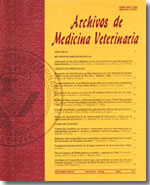(Evaluation of) Humoral and cellular immune response evaluation against Brucella abortus strain RB51 antigens in bovine
Main Article Content
Abstract
In order to comparatively evaluate the type of immune response induced by purified structural Brucella abortus antigens as well as live vaccines, 14 criollo heifers, 19 months old, were randomly distributed in five experimental groups and immunised subcutaneously with: B. abortus purified outer membrane proteins (OMP-II), B. abortus OMP-II coupled to O-chain, viable B. abortus strain RB51, viable B. abortus strain 19 (C19). A sterile saline solution was used for the control group. Two months after vaccination the animals were challenged intramuscularly with reference virulent strain B. abortus 2308. 30 days after challenge the protection level was evaluated. The humoral immune response was evaluated using conventional Rose Bengal agglutination test, complement fixation test, radial immunodiffusion as well as ELISA, western blot and dot blot assays at days 0, 8, 15, 30, 60 and 90. Additionally, the specific IgG2 isotype response was determined by double sandwich ELISA. To evaluate cellular immune responses, lymphocyte proliferation was measured by timidine incorporation and expressed as stimulation index (S.I.), IFN-? activity by ELISA and CD4/CD8 ratio by fluorocitometry. Animals vaccinated with live strains presented 100% protection against challenge, while a 66% protection was observed in those vaccinated with purified antigens. The diagnostic advantage of B. abortus strain RB51 was evidenced by the lack of humoral immune responses against sLPS in all vaccinated groups except for the strain 19 group. No significant differences (p>0.05) were detected in any of the groups by lymphoproliferation when stimulated in vitro with purified OMP-II, O-chain or sLPS. When crude soluble RB51 protein was used, S.I. turned significant (p<0.05) and indicated a better response induced by the live vaccines. IFN-?-ELISA tests with stimulated tissue cultures performed better when measured 72 hour after antigen exposure. In reference to the experimental groups, higher levels were detected in the groups immunised with live vaccine, mainly strain 19. When CD4/CD8 ratio were considered the values were constant during the observation and no differences were observed. The results confirm that B. abortus strain RB51 induced level of protection similar to strain 19, and had the advantage of differential diagnosis. Purified antigens OMP-II and OMP-II-O-chain, induced a lower level of protection but they performed similar to replicating vaccines indicating the immunodominance of OMP-II, but suggesting the need of multiple doses to reach the same level of protection. It is proposed that the protection observed in animals vaccinated with B. abortus RB51 is the result of stimulation of both T CD4 Th1 and CD8 lymphocytes by the peptides of the outer membrane proteins.

